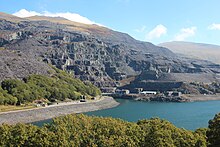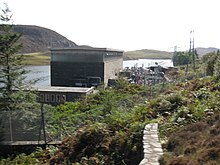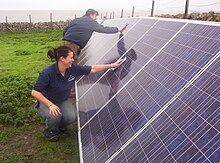
Tidal power or tidal energy is harnessed by converting energy from tides into useful forms of power, mainly electricity using various methods.

A wind farm or wind park, also called a wind power station or wind power plant, is a group of wind turbines in the same location used to produce electricity. Wind farms vary in size from a small number of turbines to several hundred wind turbines covering an extensive area. Wind farms can be either onshore or offshore.

The United Kingdom is the best location for wind power in Europe and one of the best in the world. The combination of long coastline, shallow water and strong winds make offshore wind unusually effective.

Wind power, a form of renewable energy harnessed through wind turbines, stands as a pivotal contributor to Australia's energy landscape. With an impressive total installed wind capacity reaching approximately 9,100 megawatts (MW), as of October 2023, wind power constitutes a significant portion, representing 5% of Australia's total primary energy supply and a substantial 35% of its renewable energy supply. Notably, Australia's geographic disposition favors the proliferation of wind energy infrastructure, particularly in the southern regions of the nation and along the slopes of the Great Dividing Range in the east. Approximately half of Australia's wind farms are strategically located near coastal regions.

The production of renewable energy in Scotland is a topic that came to the fore in technical, economic, and political terms during the opening years of the 21st century. The natural resource base for renewable energy is high by European, and even global standards, with the most important potential sources being wind, wave, and tide. Renewables generate almost all of Scotland's electricity, mostly from the country's wind power.

Wind power became a significant energy source within South Australia over the first two decades of the 21st century. In 2015, there was an installed capacity of 1,475 MW, which accounted for 34% of electricity production in the state. This accounted for 35% of Australia's installed wind power capacity. In 2021, there was an installed capacity of 2052.95 MW, which accounted for 42.1% of the electricity production in the state in 2020.

Renewable energy in Australia is mainly based on biomass, solar, wind, and hydro generation. Over a third of electricity is generated from renewables, and is increasing, with a target to phase out coal power before 2040. Wind energy and rooftop solar have particularly grown since 2010. The growth has been stimulated by government energy policy in order to limit the rate of climate change in Australia that has been brought about by the use of fossil fuels. Pros and cons of various types of renewable energy are being investigated, and more recently there have been trials of green hydrogen and wave power.

As of 2023, Europe had a total installed wind capacity of 255 gigawatts (GW). In 2017, a total of 15,680 MW of wind power was installed, representing 55% of all new power capacity, and the wind power generated 336 TWh of electricity, enough to supply 11.6% of the EU's electricity consumption.

Wind power generation capacity in India has significantly increased in recent years. As of 31 December 2023, the total installed wind power capacity was 44.736 gigawatts (GW), the fourth largest installed wind power capacity in the world. Wind power capacity is mainly spread across the southern, western, and northwestern states.

Wind power is the fastest-growing renewable energy technology in Scotland, with 11,482 megawatts (MW) of installed wind power capacity by Q1 2023. This included 9,316 MW from onshore wind in Scotland and 2,166 MW of offshore wind generators.

Renewable energy in the United Kingdom contributes to production for electricity, heat, and transport.

Wind power generates about 10% of Turkey's electricity, mainly in the west in the Aegean and Marmara regions, and is gradually becoming a larger share of renewable energy in the country. As of 2024, Turkey has 12 gigawatts (GW) of wind turbines. The Energy Ministry plans to have almost 30 GW by 2035, including 5 GW offshore.

Wind power constitutes a small but growing proportion of New Zealand's electricity. As of December 2020, wind power accounts for 690 MW of installed capacity and over 5 percent of electricity generated in the country.

Whitelee Wind Farm is a windfarm on the Eaglesham moor in Scotland. The main visitor centre is located in East Renfrewshire, but the majority of turbines are located in East Ayrshire and South Lanarkshire. It is the largest on-shore wind farm in the United Kingdom with 215 Siemens and Alstom wind turbines and a total capacity of 539 megawatts (MW), with the average of 2.5 MW per turbine. Whitelee was developed and is operated by ScottishPower Renewables, which is part of the Spanish company Iberdrola.

In 2021 France reached a total of 18,676 megawatts (MW) installed wind power capacity placing France at that time as the world's seventh largest wind power nation by installed capacity, behind the United Kingdom and Brazil and ahead of Canada and Italy. According to the IEA the yearly wind production was 20.2 TWh in 2015, representing almost 23% of the 88.4 TWh from renewable sources in France during that year. Wind provided 4.3% of the country's electricity demand in 2015.

As of November 2023, wind power in the Netherlands has an installed capacity of 11,602 MW, 40.9% of which is based offshore. In 2022, the wind turbines provided the country with 18.37% of its electricity demand during the year. Windmills have historically played a major part in the Netherlands by providing an alternative to water driven mills.

In Japan's electricity sector, wind power generates a small proportion of the country's electricity. It has been estimated that Japan has the potential for 144 gigawatts (GW) for onshore wind and 608 GW of offshore wind capacity. As of 2020, the country had a total installed capacity of 4.2 GW.

Renewable energy in Taiwan contributed to 8.7% of national electricity generation as of end of 2013. The total installed capacity of renewable energy in Taiwan by the end of 2013 was 3.76 GW.
Tidal Lagoon Swansea Bay was a proposed tidal lagoon power plant that was to be constructed in Swansea Bay off the south coast of Wales, United Kingdom. Development consent was granted by the UK government in June 2015, and in June 2018 the Welsh Government approved the plan and offered to invest £200 million; however, later that month the UK government withdrew its support on value-for-money grounds. Other options to enable the proposal to go ahead were reportedly still being explored.

Energy in Wales is the production of electricity in Wales.
























